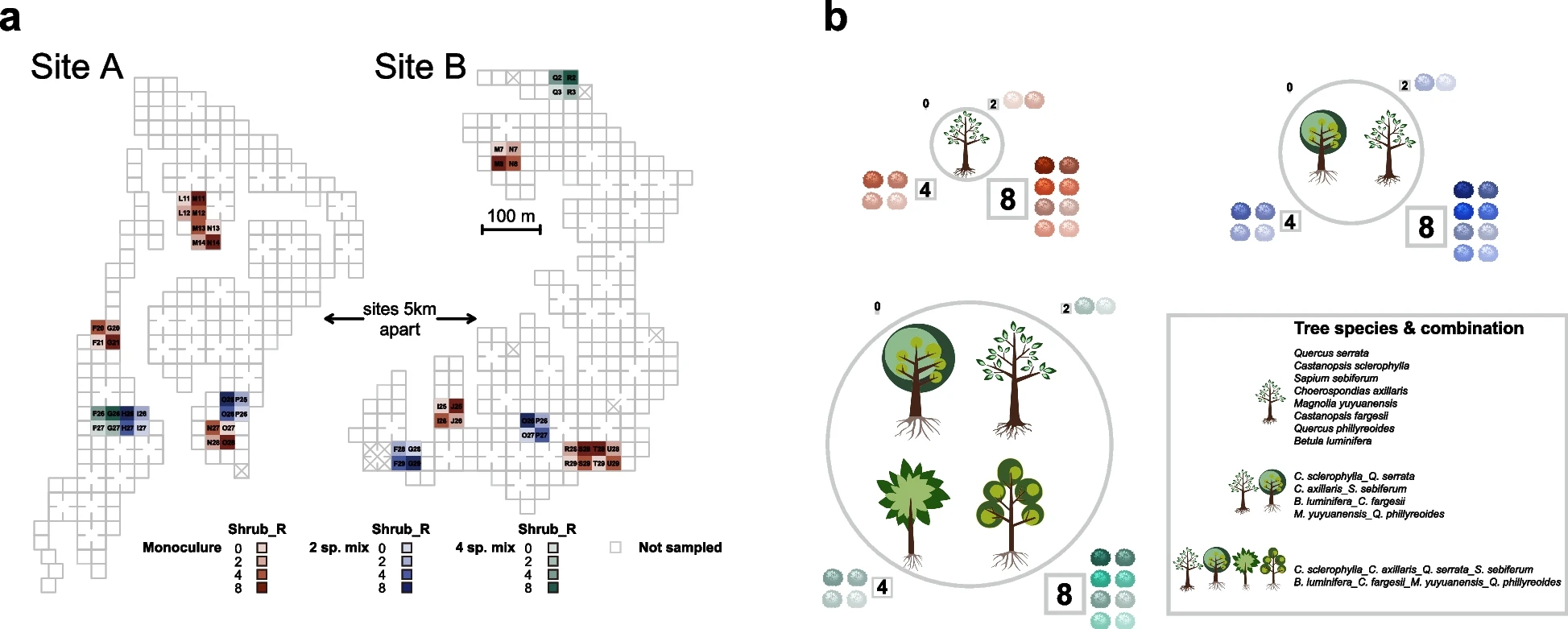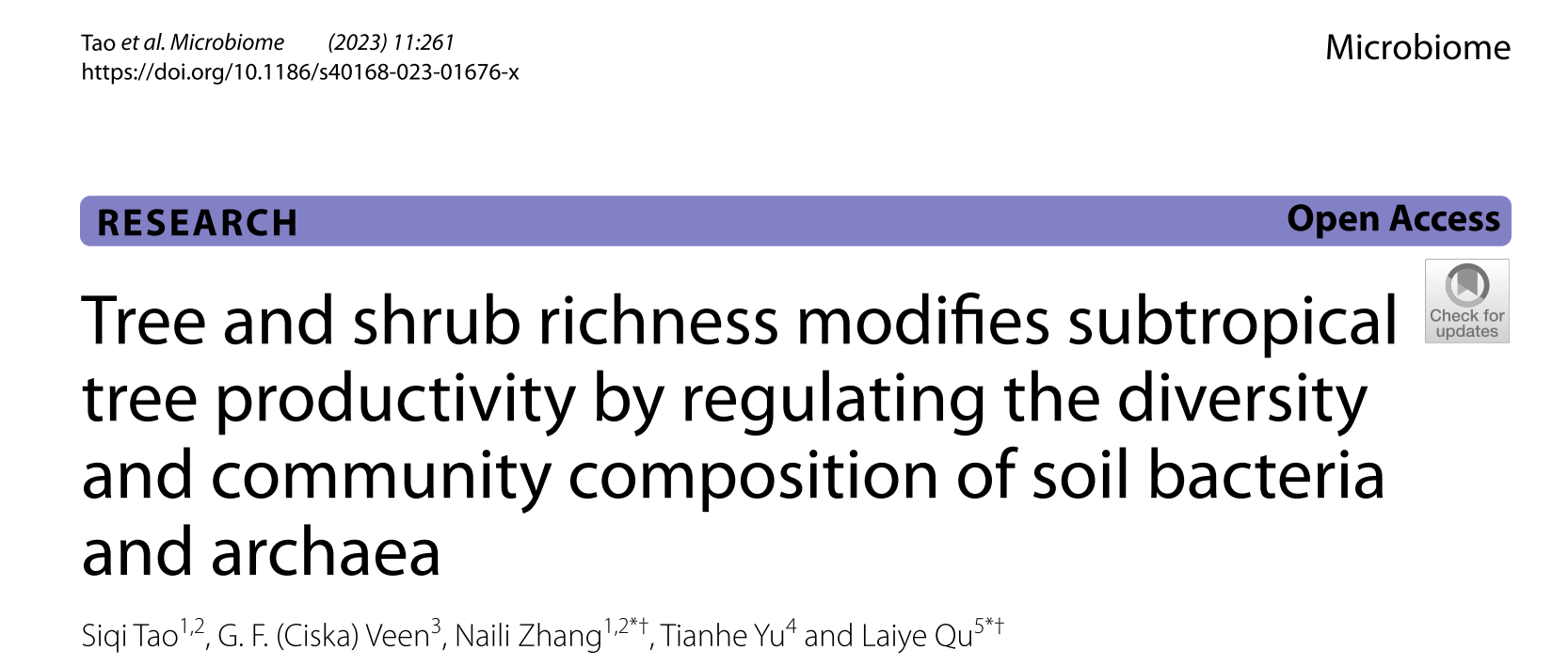Forest soils contain rich prokaryotic communities, with groups such as bacteria and archaea playing important roles in carbon flux, nutrient cycling, and decomposition. However, their contribution to forest biodiversity-ecosystem function is still unclear.
Relying on China’s large-scale subtropical forest biodiversity experimental platform (BEF-China), the research team of Naili Zhang from Beijing Forestry University, in collaboration with the research team of Laiye Qu from the Research Center for Eco-Environmental Sciences, Chinese Academy of Sciences, published a study in Microbiome titled “Tree and shrub richness modifies subtropical tree productivity by regulating the diversity and community composition of soil bacteria and archaea.” This research reveals the interactive effects of soil bacterial and archaeal communities on the diversity of trees and shrubs at different diversity gradients, as well as the regulatory mechanisms on ecosystem productivity.

Figure 1 Sampling and experimental design
The scientists utilized the large-scale Forest Biodiversity and Ecosystem Function Experimental Platform (BEF-China) established in the subtropical region of China. Through a controlled experiment on forest biodiversity, they revealed the crucial regulatory mechanisms of prokaryotic biodiversity on the relationship between tree species diversity and forest productivity.
The findings of the researchers indicate that, with the increase in the richness of tree and shrub species, the diversity, co-occurrence networks, and composition of bacterial and archaeal communities exhibit distinct patterns. Concerning bacterial communities, an increase in tree species richness leads to a reduction in bacterial diversity and the complexity of networks. The impact of shrub species richness on bacterial diversity varies across different levels of tree species richness, indicating mutual influences between tree and shrub species richness on bacterial community diversity. Additionally, the changes in bacterial communities may directly result from above-ground plant species richness or indirectly result from alterations in soil properties, such as C/N ratio and pH. As for archaeal communities, the influence of tree and shrub species richness on diversity, microbial network complexity, and composition is not evident, and soil properties almost do not alter the composition of archaeal communities.

Figure 2 Soil bacterial and archaeal α-diversity and community structure
Additionally, this study employed structural equation modeling to propose a novel mechanism, indicating that the richness of tree and shrub species significantly enhances the productivity of trees in forested areas by directly or indirectly regulating soil bacterial and archaeal communities. Specifically, the richness of tree species can, through an indirect pathway, increase bacterial diversity and regulate the composition of bacterial communities by promoting carbon and nitrogen cycling in the soil, thereby generating a chain reaction effect on community productivity. For archaea, their diversity increases only when the carbon-to-nitrogen ratio in the soil rises, potentially associated with tree species richness and contributing to the enhancement of tree productivity.

Figure 3 Plant richness affects tree productivity by regulating soil properties and microbial communities
In summary, the study reached the following conclusions:
- An increase in tree species richness significantly reduced the variability in bacterial community composition and the complexity of co-occurrence networks, and the impact of shrub species richness on bacterial α-diversity varied at different levels of tree species richness.
- The richness of tree and shrub species had a minimal impact on archaea.
- The richness of tree and shrub species significantly enhanced the productivity of trees in forest stands by directly or indirectly regulating soil microbial communities (diversity and composition of bacteria and archaea). For bacteria, tree species richness can indirectly increase bacterial diversity and regulate bacterial community composition by stimulating soil C/N, thereby creating a cascade effect on tree productivity (tree species richness –> soil C/N –> bacterial diversity and community composition –> productivity). For archaea, the richness of tree and shrub species did not directly change the diversity and composition of the archaeal community, but as soil C/N increased, the diversity of archaea increased, thereby enhancing the productivity of trees at the stand level (tree species richness –> soil C/N; soil C/N –> archaeal diversity –> productivity).
Literature:
Siqi Tao, G. F. Veen, Naili Zhang*, Tianhe Yu, Laiye Qu*. 2023. Tree and shrub richness modifies subtropical tree productivity by regulating the diversity and community composition of soil bacteria and archaea. Microbiome. 11: 261. https://doi.org/10.1186/s40168-023-01676-x.
Chinese report: https://mp.weixin.qq.com/s/oEhaybKVBOiCjaLQcDDRPQ

